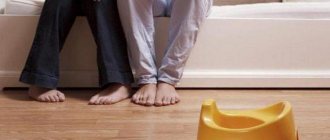Every child is an individual from birth.
He grows and develops, mastering new small and large skills every day. Each child’s skill is an achievement, which often occurs when the child himself is ready to learn something new.
The little person will have to learn to roll over, crawl, and stand.
Parents should not try to speed up any process or make it fit the average norm, but they can help their child develop physically using various methods and techniques.
When does a baby begin to learn a skill on his own?
On average, babies try to stand with support at 7-9 months .
The first tests begin with kneeling, after which the child tries to rise.
Having released his hands, the baby often immediately lands on his buttocks, but continues to show persistence in mastering the new skill.
Some children may immediately try to move along a stable base that they hold on to.
Mastering a vertical position is not an easy task.
The child makes the maximum amount of effort to achieve results. And this is a kind of warm-up for the child’s body, which is also entertaining.
There are no unambiguous standards for understanding the optimal age of a child for lifting, taking a vertical position with emphasis on the feet. Some babies can stand at 7 months, and some at . This will not be any deviation in the child’s health, since each baby is individual in its development.
If a child gets up too early or late, is that good or bad?
The development of each baby is individual. Speaking about a child’s attempts to stand up independently, we can distinguish several stages:
- 6 months - rising at this age is considered early, but not critical. When a child independently shows interest and attempts to get on his feet, and his physical health is assessed by the pediatrician as normal, then, accordingly, there is nothing wrong with such attempts to get on his feet;
- 7-9 months is the optimal period during which most children master the skill of standing up independently with support;
- after 1 year. Rising at this age is not considered critical or late if the child’s health meets the standards.
Each stage is a component of child development, a phase through which every baby goes.
Important! Early rises are considered dangerous at the age of 4-5 months. Doctors strongly do not recommend encouraging these actions, but rather distracting the child from them. At this age, the skeletal system is not developed and ready for such loads.
Why is it dangerous to put a baby on his feet too early?
Should a mother teach her baby, or maybe he should learn on his own? At what age is it considered normal to put a child on his feet?
Don't forget, this is one of the most important stages in a child's development. So let’s still look at what is healthier for such a baby.
First, let's determine how ready your baby is
- The very first and most banal thing is that the time has not come. The baby is simply not ready yet, there is no need to force him to do something against his will, especially because Masha’s neighbor, Zlata’s daughter, “has been pregnant since she was three months old.” Be patient, everything has its time, physical and mental development manifest themselves one by one.
- Nervous system. Everything should develop in stages; first, the child learns to confidently control his arms and legs and maintain balance. If the child does not have any neurological abnormalities, then all movements will manifest themselves more and more confidently. Then the child will learn to get on all fours, crawl (this is the most important period for his physical development), sit, and during these intervals the baby begins to try to stand up on his own.
- Physiology. Of course, larger babies overcome attempts to stand on their feet with more difficulty. But still, this process is individual for everyone and all factors must be taken into account. You can try to help your baby in a playful way or use play gymnastics.
- Motivation. A child, first of all, loves to imitate other children; give him the opportunity to observe other kids. And again, I repeat, use a playful form, motivate the child to stand up, for example, put a toy further away so that the baby covers some distance, so he will understand that an effort must be made.
Don’t worry if your baby isn’t standing yet; perhaps he will start talking earlier or some other developmental factors will lie ahead. Children develop in a special way, do not compare and force the child to do what he does not like or, simply, too early. Don’t rush to put the baby on his feet as soon as possible, and in general, during any activity with the baby, take into account his development. You will not teach a six-month-old child to pedal a bicycle, since he simply does not know how to walk yet and does not understand at all what they want from him. Likewise here, until the child learns to get on all fours and crawl, his spine and hip joint may simply not be ready for such loads. The baby himself will begin to gradually rise to his feet when his body is ready for this.
What other factors can influence a baby’s development?
– sleep and fresh air. And if you combine sleeping in the fresh air, it will be wonderful;
- feeding. Up to 6 months the child does not need additional feeding. It will be great if all this time the mother can fully breastfeed or with a special milk formula.
- massage. Don't forget to do a light massage daily, this stimulates the muscles and keeps them toned. Muscles will be able to maintain the alignment of the vertebrae only when they are developed and have the same strength
Therefore, it is very important to train them, and the best training for the baby’s muscles is massage at the first stage, and then crawling
IMPORTANT
In addition to the spine, standing up early can be bad for the hip joint. In some babies, the structure of the hip joint itself may be underdeveloped. And if you put a load on a defective joint, this can simply provoke subluxation or dislocation of the femoral head.
Another point is the ossification nuclei (part of the structure of the hip joint), they develop in girls at the age of approximately 4 months, and in boys at 6 months of age.
You can read articles about the development of children aged 6 months and 12 months by following the links.
Hence the conclusion: putting a baby on his feet before 6 months is not recommended. Otherwise, it may cause bone deformation.
What else should you pay attention to?
Early attempts to stand on your feet may indicate muscle hypertonicity. In this situation, contact a specialist. What is required of you is to distract the baby from trying to develop early, to support the armpits so that there is no complete emphasis on the legs and the baby does not stand on tiptoes.
Creating conditions for walking
To master one of the difficult, but very interesting skills for a little person - walking, parents can use the following approaches:
- Do not lead your child by the hand. This action significantly reduces the baby’s need for independent movement and, accordingly, delays the development of independent walking. On the street, the child can be supported in the pelvic area - protecting against improper falls. At home, the child should be given complete freedom to move along the support, taking tentative first steps, stimulating with favorite things or toys.
- Do not use devices that cause an artificial vertical position of the body - walkers or jumpers.
- Reduce the amount of time the baby spends in your arms. Provide him with more games on the floor or in the playpen.
- Provide the ability to move independently in space. It is very important here to secure the room, make it spacious and free, so that the baby does not have any obstacles in moving.
- Practice gymnastics for a child who can stand against a support. If the child has already mastered this skill, you can teach him to sit down, pick up toys from the floor and get up again.
- Insure your child less . It is normal for a child to fall on his buttocks when trying to take his first steps or stand up. Parents need to be prepared to insure their child, but try to provide conditions in which such a fall will not cause pain. For example, a place where a child can stand, leaning on something, can be covered with a soft covering made of EVA material. This way the child will be able to walk barefoot, since the floor becomes warm, and an accidental fall will not be traumatic.
- Buy a wheelchair or trolley walker. Unlike advertised walkers, which are not recommended by pediatricians, these walkers do not support the child’s body and do not disturb his balance while walking. Such a thing will serve as a toy and support, pushing which the child can take his first steps without fear of falling.
Reference! According to the recommendations of leading pediatricians, the baby's first steps around the house should not be accompanied by any shoes. It is best to ensure safe movement indoors and allow the baby to move around barefoot.
Walking barefoot
Parents often ask if their child can walk barefoot. Many do this under pressure from the older generation - grandparents are horrified when they see a toddler take his first steps with bare heels on the bare floor. There is nothing wrong with such a “walk” without shoes, Komarovsky believes, and besides, it is very useful for the child.
Nature does not provide any shoes, and therefore biologically and physiologically the child definitely does not need them. If the floor is cold and the baby is barefoot, there is no need to be afraid that increased heat transfer will occur. The child is unlikely to get sick.
When the foot comes into contact with a cold floor, the skin vessels on the baby’s legs narrow, and this is what prevents heat loss. This compensatory property is present only in human legs, but not in other parts of the body.
According to doctors, a healthy, properly developing baby should “go” in the period from 9 to 18 months, especially if favorable conditions are created for him. Which? I propose to look into the article “How to teach a child to walk independently without support” together.
Somehow, while “walking” through the Internet, I came across a message from a young mother claiming that her baby was trying to get up at almost 6 months. She is naturally delighted, but the doctor commenting on her words is not at all. He claims that the baby’s muscles are not yet strong, as is the musculoskeletal system. Consequently, the consequences of early walking can be disastrous: from incorrect foot placement to curvature of the lower leg.
The situation gets worse if the little one has certain health problems that his doctors and parents do not yet know about. True, this does not prevent the latter from trying with all their might to help the child learn to walk faster.
At the same time, such fears should not darken the mood if the baby himself tries to get up or take the first step ahead of time. In any case, Dr. Komarovsky is sure of this. According to him, a child gets up on his own if his body is already fully formed and ready for new achievements.
At what age does one begin to try to stand up?
If desired, parents can help the baby learn to stand using several techniques that should be performed systematically.
Also find out when the child begins to walk.
Methods:
On knees
The most effective exercise is the roller exercise. The roller must be placed under the little one’s tummy. The baby will feel uncomfortable and will instinctively bend his elbows and knees.
The cushion can be used under the baby's chest. This will strengthen the vestibular apparatus, stimulating the baby to spin and reach out to parents and interesting things.
Reference! A child can quickly master the pose on all fours by watching a clear example in front of him. Situational games on the floor with mom or dad will help here, where they will crawl or kneel, leaning on their hands.
On legs with or without support
You can also teach a child to stand, first with a support, then without it. As an option, a modern playpen is suitable, which usually has several special ring holders, by holding which the child learns to stand up independently.
The sides of a crib are often a handy tool, with the help of which the child can also master this skill.
There are a number of different exercises that can make getting your child back on their feet easy and fun.
Exercises for teaching a child
It is very important to show the child to an orthopedist and neurologist before starting exercises and classes. This does not mean that the baby is sick, you just need to make sure that the child is healthy in this regard. If specialists do not notice serious violations, you can do gymnastics, which will strengthen the child’s muscles and make him stand without support.
- Special jumping swings, such as walkers, develop leg muscles very well. The baby is placed in the so-called seat, the top of the swing is securely attached to the door frame or home horizontal bar using a hook. The middle of the swing is springy due to the elastic band. The baby jumps, but does not fall. With such jumps, the calf muscles, thigh muscles are trained, and the spine is also trained.
- You can teach your child to maintain balance and train his vestibular apparatus using a fitball. To do this, place the baby on a large rubber ball, belly down, and twist it from side to side, right and left. Be attentive to your child - if he doesn’t like it, it’s better to stop the exercise.
- If the child stands well at the support, but does not want to let go, use a trick. When the baby is standing by the sofa or chair, beckon him with his favorite toy or an unknown object - a ladle or a remote control (children love them so much). But the object must be large enough so that the baby needs both hands to take the new toy. Be careful not to let your child fall. He just has to take his hands off the support and reach for the toy - this is enough for the first time. Maintaining balance for a short time is already a serious achievement for a baby.
By playing with your child, you can teach him many physical skills. However, in order for the baby to learn to stand without support, you need to act comprehensively.
how to teach a child to get on all fours
Exercises
Having mastered the ability to stand up, you can give your baby a reason to use this skill as often as possible. This can be done with the help of some exercises. They will strengthen muscles, teach you to stand without support, and encourage you to take your first steps.
Classes:
- With a change of support. When the baby confidently learns to climb, relying on his usual base (at waist level), you can replace the barrier with a higher one (at chest level).
- While the child is standing, holding onto a support, you can offer him one of his favorite toys. Thus, the child will hold the toy with his hands, performing various manipulations with it, leaning on his stomach, rather than holding on with his hands.
- Squats. From a standing position, the child can be taught to sit down. To do this, it is best to use an object that arouses obvious interest in the child, placing it next to the standing baby. The child will stretch and try to sit down. Parents need to support their child in such moments.
- Stretching and moving. Place various objects or toys on a rack or other device with shelves of different heights on which the child can lean or hold on. Thus, the baby will pull his hand up and try to rise, holding on with only one hand. This exercise will serve as gymnastics to strengthen the muscular corset and leg muscles.
- Collect toys. The child should be placed at a low table, around which his favorite toys should be placed. The baby should be asked to collect the toys and put them on the table.
- Catch the ball. Hang the ball next to the support usually used by the child so that it is placed at the level of the child’s knees. The child will learn to balance by transferring weight from one leg to the other, trying to bounce a suspended ball.
- Balance board. Supported exercises can be carried out on a special balancing board.
Additionally, parents can use some techniques that will encourage the child to stand without support, feel more confident and take his first steps:
- Exercise with fitball. The gymnastics ball should not be too inflated so that the child’s butt “sinks” slightly. The parent sits the baby with his back to himself and rocks him, holding him by the body so that his legs reach the floor. The exercise will help develop coordination and teach the child to balance and hold on.
- Having the child squat, with his back to himself, supporting the body, perform rocking movements back and forth. This way the child will master balancing and get used to standing on his own, which will allow him to take his first steps.
- Favorite toy. This unique exercise is built in the form of a game. To complete it, you will need the baby’s favorite toy, which can be placed at a certain distance from the baby, thereby encouraging him to first crawl to it and then take action to get it. It is best to place or move the toy to upholstered furniture, the edge of which you can lean on to stand up. With this exercise, your child will understand how to stand independently.
Reference! A successful device for the physical development of a baby are children's sports complexes, which can be used as early as 6 months of age. A safe design, many partitions, slides, and additional devices will be an interesting and exciting way for your baby to get up, stand with or without support, and take his first steps.
How to teach a child to stand?
There may be several reasons why your baby gets up late:
- developmental features;
- heavy weight of the baby;
- phlegmatic character;
- heredity;
- low muscle tone;
- neurological character;
- premature baby.
However, if the baby is active, eats well, is developed according to his age, but does not stand on his feet, you need to help the baby learn a new skill:
- do massage and gymnastics daily. It is better to do gymnastic exercises in the first half of the day, when the baby is full, cheerful and in a good mood;
- lift by the armpits and hold in such a position that the baby stands on his legs for several seconds, then lower. To better remember actions, teach your baby to stand in the same place, for example, a playpen;
- interest the baby with a bright toy that you can pick up when you get up.
But in order to teach your child to stand up without support, you need to start doing exercises with him:
- Fitball training. Place the baby on the ball with his tummy and, holding him by the hips, tilt him in different directions. The child will learn to maintain balance, develop coordination of movements, and balance.
- Place the baby on his haunches on a flat surface (table) with his back to you. Taking your hands by the hips, begin to rock the baby, tilt it forward until he begins to try to stand on his feet.
- Attract the baby with his favorite toy, which he first places on the floor, then on the edge of the chair. The baby will first crawl behind a bright object, and then stand up, leaning on a chair.
With regular repetition of the exercises, the child will learn to stand without support, and his musculoskeletal system will be strengthened.
Walkers
When children begin to stand, parents immediately think about buying walkers. It is believed that walkers encourage the baby to learn to walk independently, and also provide the opportunity to always be close to mommy and explore new objects around him. At the same time, the baby develops a new hobby, because the models are equipped with music, light, and interesting toys.
However, some pediatricians do not recommend using a walker. After all, a child’s development should be natural. And in walkers, children do not feel the weight of their body and get used to touching the floor with their fingertips. Thanks to this, muscle tone appears, and babies learn to walk on tiptoe. Therefore, each mother needs to make her own decision whether to purchase a walker and how long to use it.
Massage to strengthen muscles
To develop and strengthen joint muscles, you can use massage techniques. The main thing to consider is that the child should not experience any painful sensations during the massage.
Sliding steps
It is necessary to wrap your hand around the child's lower leg so that the thumb is on the outside of the lower leg, and the remaining fingers are on the inside. The child's leg should be straightened and shaken slightly. Bend again so that the heel slides along the surface without leaving it. This massage is done alternately for both legs, 6 times for each .
Flexion and extension
The baby must be given the command to bend and straighten his legs. The cycle is 6 times. In the future, you can complicate the exercise a little by creating a barrier for the child in the form of each palm. Thus, the child will need to push the adult’s hands with effort. Repeat the bends 7 times .
Back massage
- Pronation.
- Stroking the baby's back.
- Use your palms and fingertips to rub in a circular manner.
- Back to stroking.
- Use the edges of your palms to run along the child’s back. The skin's response is slight redness.
- Return to stroking again.
- “Pinch” the long muscles of the back and buttocks.
- Do circular strokes.
The cycle consists of 3 repetitions.
Abdominal massage
- The starting position of the baby is lying on his back.
- Start the massage with circular strokes.
- Stroke the oblique abdominal muscles.
- Gently rub your belly with your fingertips.
- Back to stroking.
- “Pinch” around the navel.
- Finish the massage with several circular strokes.
The cycle also consists of 3 times.
The most important thing for parents should remain comfort in the baby’s feelings, his psychological readiness to begin any action. A set of gymnastic exercises and massage can serve as an excellent start to strengthening the child’s physical health.
Infant swimming will also be useful, as it trains the vestibular apparatus and strengthens the muscle corset. In any case, all physical activity will only be a plus for the baby, bringing him new emotions and sensations.
How to prepare a child for walking?
1. Laying on the stomach.
From 1 month onwards, place the baby on his stomach every day and let him try to raise his head. By performing this exercise, the muscles of the back and neck are trained.
2. Revolutions.
From the age of two months, encourage your baby to roll over. This exercise strengthens the muscles of the back, neck, arms and legs.
3. Sitting down.
From 4 months, the child can be lifted by the arms and sat down for a short time. The muscles of the abs, back, arms and neck are trained.
4. Fitball exercises.
figuradoma.ru
From 6-7 months, you can sit the baby on a fitball with his back to you and rock him in different directions, holding the baby by the hips. You can also roll your baby while lying on his tummy.
5. Crawling.
At 7-8 months the baby is ready to crawl. Hand him a toy so that he tries to crawl to it.
6. Stand at the support.
By 8 months, the baby should already be able to stand on his own feet and stand at a support for some time.
7. Squats.
Play squats with your baby, let the baby learn to jump on your lap. This exercise is very important, because for proper walking it is important to be able to bend and straighten your legs.
8. Massage.
Light strokes and touches (a nurse teaches this to young mothers) - and there is a massage, which is also aimed at strengthening the muscles of the toddler.
9. Swimming pool.
If possible, sign up for a swimming pool. This is not only useful as a hardening procedure, but also helps strengthen various muscle groups.











